Warbirds Over Delaware 2013
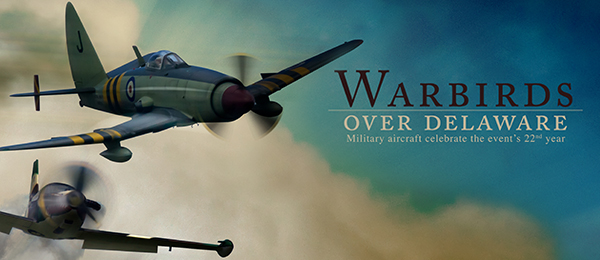
Written by Scott McClurg. Military aircraft celebrate the event’s 22nd year. Relive War Birds Over Delaware with bonus online photos. Read the entire article in the January 2014 issue of Model Aviation.
Warbirds Over Delaware began in 1992 as a handful of friends getting together to fly their Scale military airplanes for a couple days. Now in its 22nd year, Warbirds Over Delaware attracts more than 200 pilots and thousands of spectators. Pilots come from as far away as the United Kingdom and each year they seem to arrive earlier. The weekend event has grown to six days. This year’s gathering began on Tuesday, July 9, and ran through Sunday, July 14. Pilots Steven Kochinskas and Jim Bumpus may have set a record for arriving early—traveling roughly 300 miles from Massachusetts to arrive on Saturday morning before the event. No sooner did they arrive than they began helping the Delaware R/C Club prepare for the event, working for hours in the blistering sun. The club appreciates their hard work. It’s interesting to see what types of airplanes pilots bring. This year, we saw a significant rise in the number of airplanes from the Third Reich. Many of these came from members of the Tidewater Radio Control club, based in Chesapeake, Virginia, who brought an impressive 26 models to the event, including five Ju 87 Stukas to fly and a sixth that was for sale. Also included in the club’s squadron were two American airplanes in historically accurate German livery, an L-4 Cub flown by “Stuka Barry,” and a P-51 Mustang flown by Rich Schaffer.
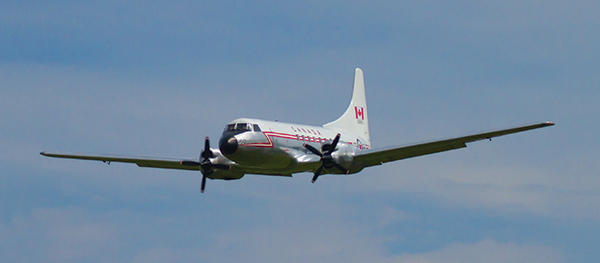 Carl Bachhuber’s Convair 580, also known as the Canadair CC-109, looks and sounds stunning.
Carl Bachhuber’s Convair 580, also known as the Canadair CC-109, looks and sounds stunning.
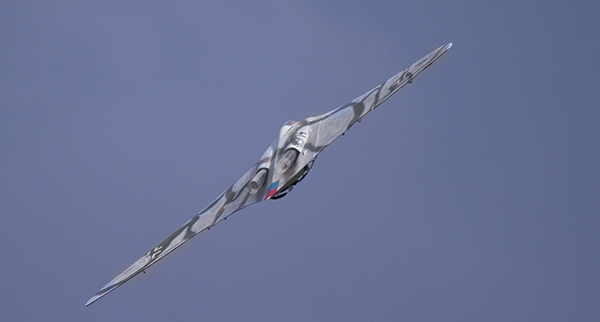 Thomas White IV and Tom Hernandez decided to build two 10-foot Horten 229s, one of which is pictured. Both models were in the air at WOD 2013.
Thomas White IV and Tom Hernandez decided to build two 10-foot Horten 229s, one of which is pictured. Both models were in the air at WOD 2013.
The most unusual of the German aircraft were the two 123-inch Horton Ho 229 flying wings built by Thomas White IV and Tom Hernandez. They started with plans for an 82-inch version provided by Wings on the Web and scaled them to 150%. Each airplane is powered by two Jet Fan 90mm units using two six-cell 5,000 mAh batteries in series for each fan. Together they produce a total of 24 pounds of thrust and provide 4 minutes of flight time. Because of the airplanes’ glide characteristics (or lack thereof), they say, “Four minutes, you land. Six, minutes you crash.” Better remember to turn on the timer! The center section of each airplane is a composite made of Aero-Mat, covered in fiberglass, and reinforced with carbon fiber in key areas. It’s built using vacuum infusion, a process that uses a vacuum to compress the materials as well as embed the epoxy. The wings are standard, built-up balsa. Takeoffs and landings are challenging with the Horton. Applying full throttle and full up-elevator, the aircraft takes off when it feels like it. The rest of the time, it behaves much like a sport flier and is remarkably docile, especially considering it has no vertical control surfaces.
Delaware R/C Honors Four Pilots
There are a number of outstanding pilots and builders who annually attend Warbirds Over Delaware. Four such pilots stood out this year and were recognized by the Delaware R/C Club. Paul LeTourneau, Dave Wigley, Carl Bachhuber, and Mac Hodges received trophies, honoring their continued support of Warbirds Over Delaware, their remarkable aircraft, skill, heart, and willingness to travel as much as 17 hours to attend. Paul LeTourneau brought three remarkable airplanes: a North American B-25 Mitchell bomber with the famous Panchito paint scheme, a Lockheed T-33 Shooting Star powered by a single turbine, and a Fairchild Republic A-10 Warthog powered by twin 90mm turbines. The B-25 was built from Nick Ziroli plans that Paul scaled from 101 inches to more than 160 inches. The 76.5-inch-wingspan T-33 was built from a Jet Model Products kit and has a beautiful aluminum finish. The A-10 was built from a MiboJets kit and has a 118-inch wingspan. Carl Bachhuber brought two gigantic, twin-engine aircraft: a 180-inch Lockheed Hudson and 200-inch Convair 580. The Scale airplanes look as amazing on the ground as in the air. The two aircraft are rarely modeled, but I have to wonder why. They are amazing. The Hudson was an American airplane flown by the British during World War II. It was a short-range aircraft used primarily for antisubmarine duty. Carl’s model weighs approximately 105 pounds. The scale flaps are operated by jackscrews. The Convair 580, also known as the Canadair CC109 Cosmopolitan, was an airliner developed shortly after WW II. It was used by the Canadian Armed Services through the mid-1990s as a VIP transport aircraft. Carl’s model is done in military livery and features a servo-operated rear door that opens and reveals a Canadian Mountie. On the trip to Delaware, Carl’s trailer hit a large pothole and the fuselage of Carl’s Convair was thrown hard enough that a section behind the cockpit was crushed, and then landed hard on a beam in his trailer, crushing the bottom of both engine nacelles. He was able to make sufficient repairs at the field to fly the Convair the next day. Carl would like to offer his thanks to those who came to his aid offering tools, supplies, and anything else he needed to complete his repairs. Carl Bachhuber (L) works on his Lockheed Hudson while Mac Hodges (center) preflights his B-29.
Carl Bachhuber (L) works on his Lockheed Hudson while Mac Hodges (center) preflights his B-29.
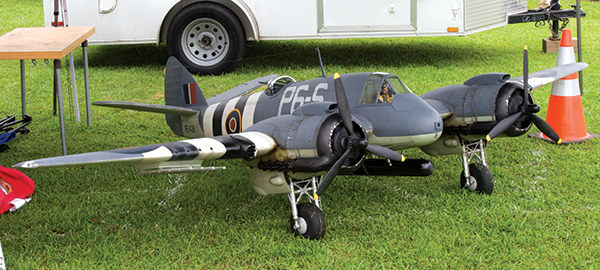 The cockpit and pilot detailing on Dave Wigley’s Bristol Beaufighter further enhances the beautiful model.
The cockpit and pilot detailing on Dave Wigley’s Bristol Beaufighter further enhances the beautiful model.
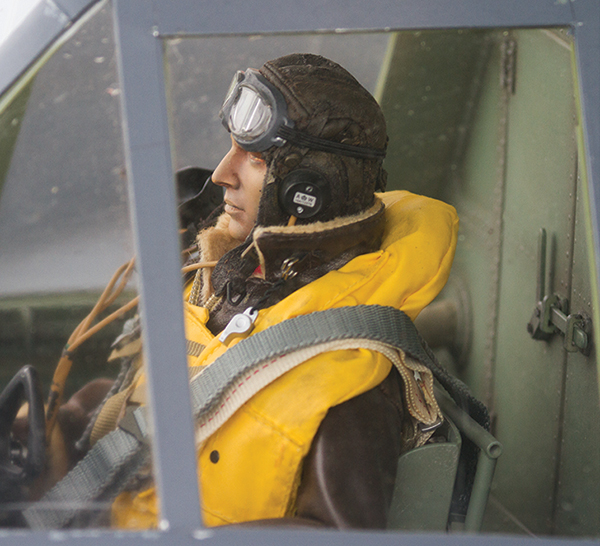 Close up of cockpit and pilot detailing of the Bristol Beaufighter.
Close up of cockpit and pilot detailing of the Bristol Beaufighter.
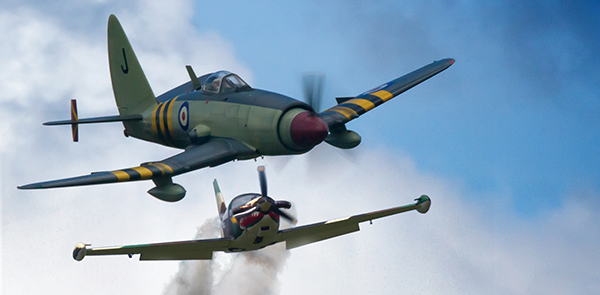 Dave Wigley’s Westland Wyvern and Andy Kane’s 112-inch CARF Models SIAI Marchetti SF-260 look amazing in the air.
Dave Wigley’s Westland Wyvern and Andy Kane’s 112-inch CARF Models SIAI Marchetti SF-260 look amazing in the air.
If you’ve never seen one of Dave Wigley’s aircraft up close, you’ve missed out. There’s a reason he is a four-time Mr. Top Gun winner. The detail Dave puts into his models is amazing, including rivets and a scale handle on the door inside a closed cockpit. Dave brought two award-winning models with him: his 1/5-scale Bristol Beaufighter, winner of the 2013 Mr. Top Gun award, and his 1/5-scale Westland Wyvern, a three-time winner of the Mr. Top Gun award. The Beaufighter weighs 85 pounds and took Dave five years to complete. He drew his own plans from measurements from the full-scale airplane, three-views, and more. He built the entire airplane and all of its mechanical elements with the exception of the two BME 100cc gas engines that power it. Building the landing gear alone took a year. Dave’s Westland Wyvern is just as amazing. He demonstrated beautiful scale flying and aim, dropping his torpedo in the center of the runway. The Wyvern features twin inline contra-rotating propellers. The forward propeller is freewheeling and the rear is powered. That arrangement performs well and produces a sound unlike anything I’ve ever heard. The Wyvern is a challenge to start. Dave has to get his hand between the front and rear propellers to start it by hand. Dave has done this often and has it down to a science. Mac Hodges and his team again brought their amazing 20-foot-wingspan Boeing B-29 bomber and Bell X-1. These airplanes have been written about many times and seeing them in action, there’s no doubt why. The current B-29 is Mac’s third. Powered by four DA-100 engines, it's capable of hovering and performing a torque roll—something Mac does twice during each of his performances. Mac’s first B-29 had a 16-foot wingspan and was based on Bob Campbell plans. It was begun by his friend, Larry Horbacz, who passed away from leukemia in 1989 before finishing the aircraft. Mac completed the airplane as a tribute to Larry. It was first flown in 1994. Larry’s parents and brother were there and many tears were shed. In approximately 1995, Mac’s friend, Dan Stevens, came up with the idea for the X-1 and built one to the scale of the B-29. The first B-29 was destroyed during a performance when a wing folded during a roll. It had been flown roughly 225 times. Mac had Dan Stevens build a second B-29, this time with a 20-foot wingspan. That model crashed in 2008 when a wing folded while exiting a flat spin. Not to be deterred, Mac had John Monahan build a third B-29, which he still flies today.
The People You Meet
More than anything, I can always count on meeting amazing people at Warbirds Over Delaware and making new friends. While Paul LeTourneau and Dave Malchione prepared to fly their turbine-powered A-10s together, a crowd gathered. One of those watching was Bob Farris, from Wilmington, Delaware. Bob is a full-scale pilot who began his flying career in the military flying helicopters in Vietnam. Later, he transitioned to fixed-wing aircraft.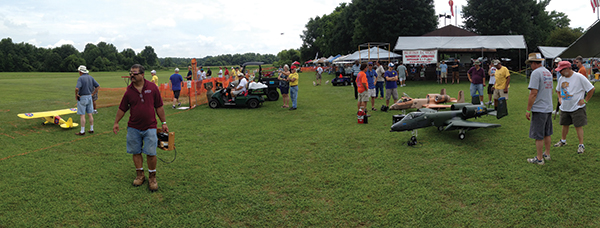 Pete Malchione (orange shirt), Paul LeTourneau, and Dave Malchione Jr. (all at right) prep their A-10s.
Pete Malchione (orange shirt), Paul LeTourneau, and Dave Malchione Jr. (all at right) prep their A-10s.
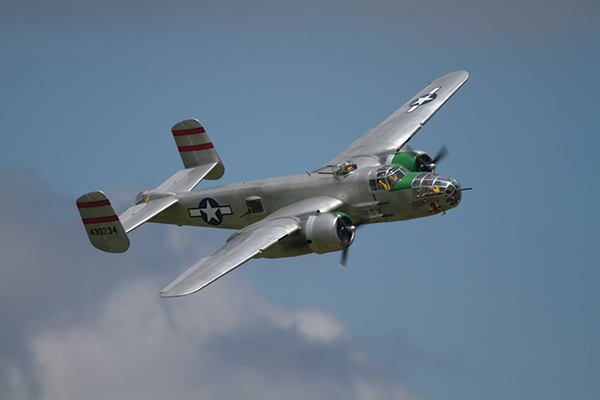 One of the stunning bombers at the event, Paul LeTourneau’s 13.5-foot span B-25 in the Panchito paint scheme, roars past.
One of the stunning bombers at the event, Paul LeTourneau’s 13.5-foot span B-25 in the Panchito paint scheme, roars past.
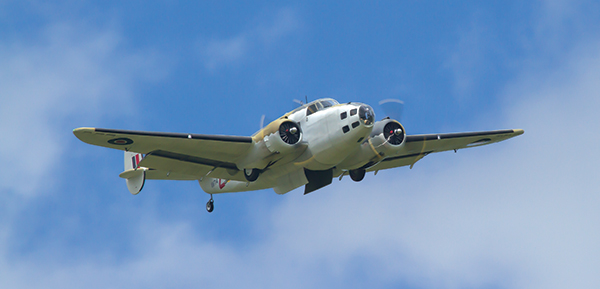 The 15-foot-wingspan Lockheed Hudson shortly after a bombing run. The full-scale aircraft was used primarily for anti-submarine duty.
The 15-foot-wingspan Lockheed Hudson shortly after a bombing run. The full-scale aircraft was used primarily for anti-submarine duty.
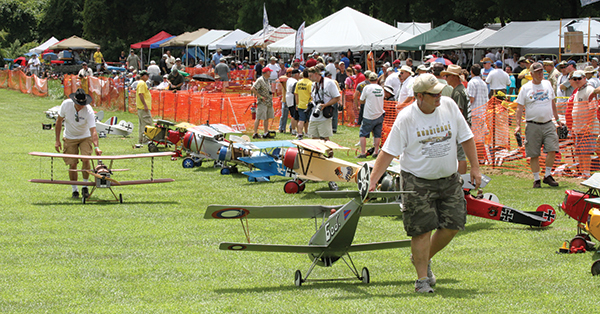 Pilots prepare for the popular WW I Gaggle. (Photo by Roger McClurg.)
Pilots prepare for the popular WW I Gaggle. (Photo by Roger McClurg.)
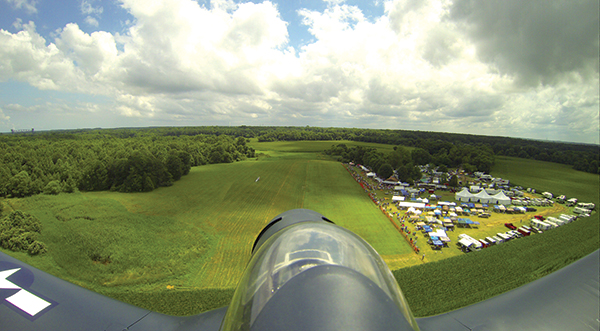 Corsair cockpit view over the flying field.
Corsair cockpit view over the flying field.
When Bob retired from the military, he had more than 450 hours in the A-10. Bob also flew CL in his youth. We tried to get him back into modeling at the event. He declined, saying he wouldn’t have time, but there was a glint in his eye. I wouldn’t be surprised to see him at the Lums Pond Flying Field again. I also met Marine Corps Pfc. Justin Schnegelsberger. Justin serves as a maintenance mechanic for the EA-6B Prowler. He’s been flying RC since he was eight and flew a beautiful Fokker Dr.I at this year’s event. Currently based in Cherry Point, North Carolina, Justin had a long drive to make it to Warbirds Over Delaware and we appreciate it. He’ll be deployed to Kuwait in January. We’d like to thank Justin for his support of the event and his service to his country.
About the Event
Warbirds Over Delaware is put on by the Delaware R/C Club and is an International Miniature Aircraft Association- (IMAA) and AMA-sanctioned event. Pilots must have both AMA and IMAA membership and their airplanes must be Scale warbirds that meet the IMAA’s requirements. Monoplanes must have at least an 80-inch wingspan or be 25% scale. Models with more than one wing must have at least a 60-inch wingspan or be 25% scale.Special Thanks
I’d like to offer special thanks to Mac Hodges, Larry Andrese, and Dave Malchione. All three allowed me to mount a camera to their magnificent airplanes. Larry and Mac had never even met me. Dave knew me and could have hunted me down had anything gone wrong, but the mount worked perfectly and we all had a lot of fun with it.Bonus Photos
—Scott McClurg
[email protected]
Sponsors
Horizon HobbyPacer Technology (Zap)
Frank Tiano Enterprises
Great Planes
Robart Manufacturing
Sullivan Products
Model Airplane News
Balsa USA
IFlyTailies
SKS Video
Nick Ziroli Plans
Sources
Warbirds Over Delawarewww.delawarerc.org/warbirds










2 comments
Warbirds Over Delaware
people you meet
Add new comment